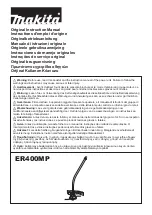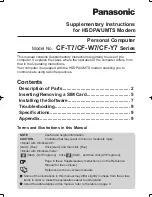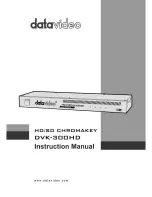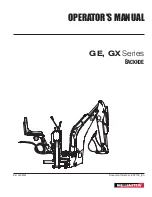
Belt Safety Instructions - Please Read!
Wearing the Respiration Belt
1. Wrap the right portion of the belt
(the side with the tubes) around
your chest (the lower part of your
rib cage). The hook-and-stick
strips should face away from your
chest.
2. Wrap the left half of the belt over the
right part, so that the hook-and-
stick
straps stick to each other. The
belt needs to fit snugly around the
rib cage, but not so tight that
breathing becomes restricted (See
Figures 1 and 2).
Figure 1
Wrap this
end first.
Collecting Respiration Data
CARD 2A
1. Wrap the respiration belt around
the lower part of your chest.
2. Push the quick-release connector
on the tubing of the Respiration
Belt into the port of the Relative
Pressure Sensor. Turn the
connector clockwise until it clicks
into place.
3. Connect the pin connector on the
Relative Pressure Sensor to the
interface (i.e. USB Link, etc.).
[
Note:
The
Xplorer
can be used
for collecting pressure data, but
not respiration rate data. (For pressure studies, see the reverse side of
this card).]
4. On the squeeze bulb, turn the knob fully clockwise to close the valve.
5. Squeeze the bulb 10-20 times to inflate the rubber bladder. (
WARNING:
Do not overflate!
Please see read the safety instructions on the left side
of this card.) When the bladder is inflated, the belt will feel more snug
against your chest.
6. In DataStudio, use the Calculator dialog to create an equation for the
respiration rate (See detailed instructions on card 1B.)
7. To begin collecting data, click the
Start
button. To stop data collection,
click the
Stop
button.
8. To deflate the belt, turn the knob on the squeeze belt counterclockwise to
open the valve. Use your hands to push air out of the bladder. To
disconnect the quick-release connector from the pressure port, turn it
counterclockwise.
Figure 2
bulb
squeeze
Pressure
Sensor
belt
WARNING:
Do not inflate or wear the belt beyond an individual’s
comfort level. Overflating the belt or wearing the belt too snugly could
cause excessive pressure against the chest or abdominal cavities,
etc., resulting in possible bodily injury or harm to internal organs.
Overinflation may also tear the bladder belt. When inflating the belt, squeeze the
bulb slowly and allow adequate space for comfortable breathing to take place (at
least one-finger width between the belt and body surface). If the belt is
uncomfortable, unwrap the hook-and-stick straps and remove the belt. To deflate
the bladder, turn the knob on the squeeze bulb counterclockwise to deflate the
bladder. Before using the product, inform your students of the hazards of
overinflating the belt and show students how to properly inflate, deflate, and
remove the belt. PASCO cannot be held responsible for unsafe usage in the
classroom.
012-08370A
800-772-8700 • 916-786-3800 • [email protected] • www.pasco.com
!
1. Do not use the Pressure Sensor around liquids or beverages.
Also, be careful not to get water or other liquids in the squeeze
bulb, tubing, or bladder of the belt. Liquids will permanently
damage the sensor and will also interfere with proper inflation of
the bladder in the belt.
2. Before each data run, ensure that the valve to the sqeeze bulb is
completely closed. If the valve is left partially open, the release of
air from the belt could skew data results.
3. To ensure measurement consistency, before each data run, check
to ensure that the pressure in the belt is at the same baseline
starting level.
4. When using the sensor with a PASPORT Xplorer, only pressure
data will appear on the Xplorer display screen. Respiration rate
Rate data does not display on the Xplorer.
CARD 2B
Recording Lung Pressure Changes
with the Respiratory Sensor
You can directly measure the inspiratory and expiratory pressures by having the
students breathe through a plastic tube (using the tubing and connectors
provided) connected to the Relative Pressure Sensor. Remove the Pressure
Sensor from the belt, connect it to the plastic tubing, and have a student breathe
through the tube. The lung pressure (in the
alveoli
, the air-filled sacs in the
lungs) normally drops about 1 mm Hg during inspiration and rises about 1 mm
Hg during normal expiration.
(WARNING:
Sucking directly from the tube is not
recommended, because it would create a vacuum effect in the sensor.
Also, as
a health precaution, always remember to wash and/or disinfect the tubing and
connectors before and after use or between students.)
Sample Pressure Data with the Respiratory Sensor
Respiration Sensor Usage Tips
Note:
When the belt is connected to the Relative Pressure Sensor, the Pressure
Sensor measures the pressure in the bladder of the belt as the lungs expand and
contract. The pressure of the lungs and chest cavity expanding causes pressure
against the bladder of the belt, but the pressure measured is not the actual
pressure change in the lungs. (Any positive pressure change in the belt
corresponds to a negative pressure change in the lungs and vice versa.)
The movement of the diaphragm facilitates
respiration by changing the size of the chest
cavity. During inspiration, the lungs expand
with air, and the diaphragm moves down in
the abdominal cavity, increasing the space
and decreasing the pressure in the chest
cavity (Figure 3). During expiration, the
pressure in the lungs is higher than the
atmospheric air pressure, and the lungs
recoil to expel the air, while the diaphragm
moves up toward the chest cavity.
diaphragm
lungs
muscle
Figure 3
Pressure Changes During Respiration




















